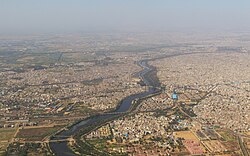This article needs to be updated.(May 2019) |
| Masani barrage and bridge | |
|---|---|
 Sahibi River at Delhi | |
| Country | India |
| Location | Masani in Rewari District |
| Coordinates | 28°12′17″N76°43′45″E / 28.20481°N 76.729245°E |
| Status | Functional |
| Construction began | February 1979 |
| Opening date | 1989 |
Masani barrage, also Masani bridge, a barrage on the seasonal Sahibi River completed in 1989, [1] is named after the Masani village in Rewari District of Haryana in India. [2] [3] Masani barrage also serves as a bridge on NH 919. [4] Water storage in the barrage was made perennial in 2017 after a gap of 50 years. [5] This barrage is important part of ecological corridor along the route of Sahibi river which traverses from Aravalli Range in Rajasthan to Yamuna via Matanhail forest, Chhuchhakwas-Godhari, Khaparwas Wildlife Sanctuary, Bhindawas Wildlife Sanctuary, Outfall Drain Number 8 and 6, Sarbashirpur, Sultanpur National Park, Basai and The Lost Lake (Gurugram).


